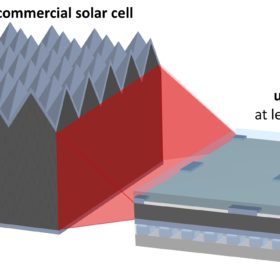
A new French study highlights the potential of ultra-thin PV cells, but the road to commercial production will be challenging. The researchers have proposed a series of novel cell architectures integrating photonic and electronic elements.
A group of scientists from the French National Centre for Scientific Research has conducted a study to assess the potential and limits of ultra-thin solar cells based on crystalline silicon, gallium arsenide (GaAs), and copper indium gallium selenide (CIGS).
In “Progress and prospects for ultra-thin solar cells,” which was recently published in Nature Energy, the scientists claim that producing solar cells at least 10 times thinner than commercial ones would be much cheaper, due to the significantly lower amount of materials required. An associated decline in deposition times associated with thinner cell layers would also result in higher production throughput and lower capital investment costs.
“We see no limit in the application of ultra-thin solar cells in the future,” researcher Stephan Colling told pv magazine. “Once technological challenges will be overcome, they may provide cost advantages and material savings without drawbacks.” ‘
Solar cells currently use too many materials, but ultra-thin solar cells might have the same properties and offer the same performance, once they are fully developed and industrialized.
“For crystalline silicon, the trend is to reduce the thicknesses of solar cells and this research will stimulate the trend,” Colling said. “We may expect silicon solar cells as thin as about 50 µm within a few years, but going thinner would require drastic changes in the fabrication process.”
The research team said that the current optical approach used in the development of such cells is not sufficient, as lowering the thickness of the absorber material too much could jeopardize the complete architecture of the solar cell.
“Overall, the issues of carrier photogeneration and collection are deeply interconnected and thinning the absorber further constrains the realization of selective contacts and passivation layers,” the group said.
Strategies used to enhance light absorption in crystalline cells are more complex. Industrially viable ultra-thin solar cells may be achieved by “applying bottom-up growth methods and scalable patterning techniques to the processing of 10-μm-thick silicon cells to reach efficiencies above 15%,” the scientists said.
GaAs-based ultra-thin cells are considered a model device to explore novel light-trapping strategies that could be applied to other materials.
“For III-V, ultra-thin solar cells have a clear advantage for space application, due to their longer lifetime, so we anticipate strong efforts in this direction, and possible applications in the mid term,” Collin said.
The first commercial products will likely be CIGS and cadmium telluride (CdTe) cells.
“These technologies can benefit from a thickness reduction without a big change in the cell structure nor the fabrication process,” Collin added.
The main technological challenge is the development of a back contact that can sustain high CIGS deposition temperatures of approximately 500 C, while providing high optical reflectivity and forming an ohmic contact with CIGS, with low surface recombination.
The researchers added that multi-junction ultra-thin cells may also become a promising application, but there are still issues with efficient light trapping on an overall broadband spectrum and current matching between the subcells. Yet Collin is convinced that ultra-thin solar cells could be used in building integrated photovoltaics (BIPV).
“Light trapping will play a role not only in increasing the optical path but also in modulating the spectral absorbance of semi-transparent solar cells,” he concluded.
Lắp đặt điện mặt trời Khải Minh Tech
https://ift.tt/2X7bF6x
0906633505
info.khaiminhtech@gmail.com
80/39 Trần Quang Diệu, Phường 14, Quận 3
Lắp đặt điện mặt trời Khải Minh Tech
https://ift.tt/2ZH4TRU
Không có nhận xét nào:
Đăng nhận xét